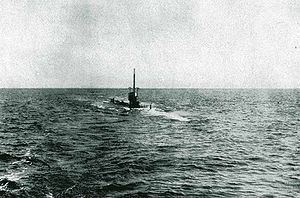Name U-35 Yard number 195 Commissioned 3 November 1914 Launched 18 April 1914 Draft 3.56 m | Ordered 29 March 1912 Laid down 20 December 1912 Construction started 20 December 1912 Length 65 m | |
 | ||
Builder | ||
SM U-35 was a German U 31-class U-boat which operated in the Mediterranean Sea during World War I. It ended up being the most successful U-boat participating in the war, sinking 224 ships for a total of 539,741 gross register tons (GRT).
Contents
Her longest serving captain was Lothar von Arnauld de la Perière, who is famous for scrupulous adherence to prize rules, allowing crews of enemy merchant ships to board their lifeboats and giving them directions to the nearest port before sinking their ships. Under his command, U-35 sank 195 ships, making him the most successful submarine commander in history.
Design
German Type U 31 submarines were double-hulled ocean-going submarines similar to Type 23 and Type 27 subs in dimensions and differed only slightly in propulsion and speed. They were considered very good high sea boats with average manoeuvrability and good surface steering.
U-35 had an overall length of 64.70 m (212 ft 3 in), her pressure hull was 52.36 m (171 ft 9 in) long. The boat's beam was 6.32 m (20 ft 9 in) (o/a), while the pressure hull measured 4.05 m (13 ft 3 in). Type 31s had a draught of 3.56 m (11 ft 8 in) with a total height of 7.68–8.04 m (25 ft 2 in–26 ft 5 in). The boats displaced a total of 971 tonnes (956 long tons); 685 t (674 long tons) when surfaced and 878 t (864 long tons) when submerged.
U-35 was fitted with two Germania 6-cylinder two-stroke diesel engines with a total of 1,850 metric horsepower (1,361 kW; 1,825 bhp) for use on the surface and two Siemens-Schuckert double-acting electric motors with a total of 1,200 PS (883 kW; 1,184 shp) for underwater use. These engines powered two shafts each with a 1.60 m (5.2 ft) propeller, which gave the boat a top surface speed of 16.4 knots (30.4 km/h; 18.9 mph), and 9.7 knots (18.0 km/h; 11.2 mph) when submerged. Cruising range was 8,790 nautical miles (16,280 km; 10,120 mi) at 8 knots (15 km/h; 9.2 mph) on the surface, and 80 nmi (150 km; 92 mi) at 5 knots (9.3 km/h; 5.8 mph) under water. Diving depth was 50 m (164 ft 1 in).
The U-boat was armed with four 50 cm (20 in) torpedo tubes, two fitted in the bow and two in the stern, and carried 6 torpedoes. Additionally U-35 was equipped in 1915 with one 8.8 cm (3.5 in) deck gun, which was replaced with a 10.5 cm (4.1 in) gun in 1916/17. The boat's complement was 4 officers and 31 enlisted.
Service history
U-35's keel was laid on 20 December 1912 at the Friedrich Krupp Germaniawerft shipyard in Kiel. Its delivery date was supposed to be 1 March 1914, but it was delayed due to development problems with its diesel engine. U-35 officially entered service on 3 November 1914, under the command of Kapitänleutnant Waldemar Kophamel. The lead engineer was Hans Fechter. It sailed with the II Flottille, stationed in Helgoland.
U-35 completed its first two deployments in reconnaissance actions in the North Sea. In its following three actions, U-35 sunk 17 merchant ships, for a total of 25,716 GRT. Later, it was paired with U-34 after a battle near Cattaro, Montenegro, and sunk three merchant ships for a total of 4,067 GRT. U-35 made two more voyages and destroyed 15 more merchant ships totaling 59,409 GRT. These included on 23 October 1915 the British transport Marquette in the Aegean Sea. She was carrying an Ammunition Column of the 29th Division; and also staff of the 1st New Zealand Stationary Hospital, despite a British hospital ship Grantully Castle sailing on the same route on the same day.
On 9 November 1915, U-35 sank the SS Californian, a cargo ship best known for its inaction during the sinking of the RMS Titanic on 15 April 1912, despite being the closest ship in the area.
On 18 November 1915, Kptlt. de la Perière took command of U-35. He led 15 missions, primarily in the Mediterranean, and sank 189 merchant ships for a total of 446,708 GRT. Additionally, U-35 sank the British gunboat HMS Primula on 29 February 1916 and the French gunboat Rigel on 2 October 1916.
On 26 February 1916, she successfully torpedoed and sank the Armed merchant cruiser La Provence, carrying 1,800 French troops, near Cerigo Island with a loss of 990 men.
U-35's fourteenth patrol (26 July to 20 August 1916) under de la Perière stands as the most successful submarine patrol of all time. During that period, 54 merchant ships totaling 90,350 GRT were sunk.
She also sank on 4 October 1916, the French transport ship SS Gallia, leading to the death of between 600 and 1,800 men.
Kptlt. Ernst von Voigt took command of U-35 on 17 March 1918. He undertook two patrols, an enemy engagement and a redeployment cruise, between 7 September and 9 October 1918, but both were promptly broken off because of engine damage. On 14 October 1918, Kptlt.. Heino von Heimburg took command and U-35 was transferred to Kiel.
Fate
After World War I ended, U-35 was transferred to England and docked in Blyth from 1919 to 1920, then broken up.
